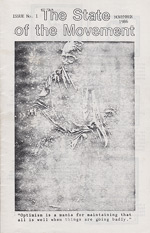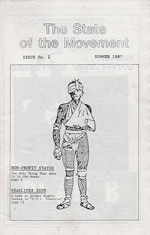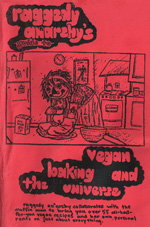The Archives
-
Most Popular, One-off publications
Raggedy Anarchy’s Guide to Vegan Baking and the Universe
02.23.12 | PermalinkRaggedy Anarchy’s Guide to Vegan Baking and the Universe (1989? Carmichael, CA)
Consumer culture is rampant in its appropriation and assimilation of radical ideas, taking things that were once revolutionary (including the word “revolutionary” itself!) and turning them into products to be purchased or new forms of advertising. DIY Skater culture became a vehicle for hocking Mountain Dew, Tylenol, and Nike shoes, hardcore music influenced the crappy, commercial “now I’m singing, now I’m yelling” garbage heard on the radio today, and in a world where sorority girls have knuckle tattoos and think Discharge is a clothing brand, can punk still be a threat? These subcultures may have never truly threatened the system, but at one time they provided a safe space from it, and in that space some truly liberatory ideas flourished.
If you have grown up in a world where vegan cookies are sold at supermarkets and every animal free product imaginable can be bought on the internet, veganism might just seem to be one more compartment in the consumerist toolbox. But there was a time when this wasn’t so. In the early days of veganism you had to be seditious to even consider such a thing. It was unheard of, and given cultural resistance to the changing of food choices, it was also rebellious. While many health oriented and religious groups had advocated an animal free diet, animal rights oriented veganism was uncharted territory. (And at times unwelcome in the animal rights community! Many New Zealand anti-vivisection societies ran newsletter articles in the late 70’s and early 80’s warning of possible “infiltration” efforts by vegans!) On it’s path to mainstream acceptance, the first pioneering steps were taken very often by punks, hardcore kids, and others existing on the fringes.
Because being a vegan was such a new concept at the time, people simply did not know how to do it. Recipes and helpful hints began spreading through album liner notes, self published cook-zines, and the network of all ages venues that began springing up in the late 1970s. Making veganism accessible to the young and poor brought animal rights into communities that were already resistant to cultural norms, and soon animal liberation joined the roster of causes tattooed on the hearts of misfits everywhere. Diets were changed, but more importantly, action was taken. For proof we present Raggedy Anarchy, an amazing cook-zine that was hugely influential on the likes of Isa Moskowitz and others, written by a young punk and hunt saboteur from California.
Raggedy Anarchy will help you make delicious cakes, but it will also spark your desire to subvert the omnicidal paradigm! Sometimes funny, sometimes introspective, and always inspiring, we post this classic in the hopes of making Snacktivism a threat again and convincing our readers to “bake for themselves what tomorrow never brings!”
…
-
Periodicals
State of the Movement
03.28.11 | PermalinkState of the Movement #1-3 (1986-1990, Tarzana, CA USA.)
If there was ever a zine series that I wish I could provide Cliff’s Notes for, it would be State of the Movement. SOTM wielded political cartooning the most way other people wield blades, and its editors stabbed at what they saw as hypocrisy and weakness in the movement’s personalities and philosophies. Many of the references made in these cartoons will be lost on younger activists, but we offer the following brief explanation.
The 1980s was a time of explosive popularity in the animal rights movement, and initially, that boom brought together some very unlikely people. Celebrities like Bob Barker held meetings where Rod Coronado would be seated next to the heads of welfare groups. Mass marches took place in cities all across the United States, with tens of thousands of people participating in demonstration on major days such as World Day for Animals in Laboratories and Fur Free Friday. But amidst all this activity, the con artists and career builders were lurking. The tremendous potential for fund raising also meant a corollary potential for salaries, and after a while, the mainstream groups had well-paid executives who wanted to do anything they could to avoid offending their donor base. The philosophy of the movement was weakened as calls for the abolition of vivisection became calls to stop using “pound seized pets” in experiments. Activists who had once loudly supported direct action began whispering supportive words to militants in one breath and then denouncing them to the media in another. Compromise spread like melted soy margarine and soon the whole movement was covered in the oily goo of half-assery!
Amidst this rush to mediocrity, State of the Movement mercilessly mocked those who were selling the animals futures down the drain. The events of the 1980s impact this movement still. We can not provide a comic by comic explanation, but we do hope that people will research this bygone period and learn from the mistakes of the failed movement “leadership” at that time.



…
-
Periodicals
Spectacular Times #10: Animals
03.14.11 | PermalinkSpectacular Times #10: Animals (1980? UK.)
In the late 1970s and early 1980s, Larry Law authored a series of booklets analyzing various issues from a situationist perspective. Consisting of statements by Law, cut and paste articles taken from newspapers at the time, and a little bit of humor, the Animals issue of Spectacular Times reminds of us the deep connections between animal liberation and situationist thought. (Ronnie Lee says that the founding of the ALF was influenced by his appreciation for the Angry Brigade, a British armed revolutionary group whose politics some, Lee included, mark as situationist.)
One article inside concerns the ambivalence and even animosity directed at the animal rights movement from the British left. “Despite all this activity the animal liberation groups are largely ignored by other political groups. Perhaps the politicos are ashamed. In the past five years the animal liberation activists have undertaken more direct action and caused more physical and financial damage to their enemies than the entire British revolutionary left put together. (Including those groups who claim to hold ‘direct action’ as a basic tenet of their philosophy.)” The booklet continues in much the same vain and makes for a great, albeit short read.
…






